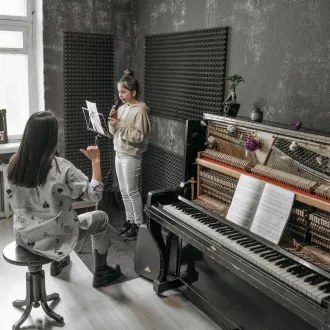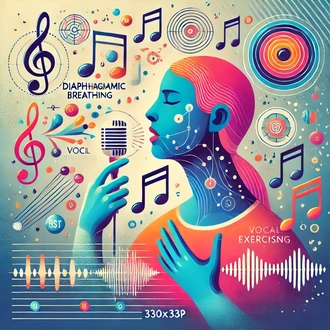Transcription The voice as an instrument
The voice is a powerful and unique instrument that we all possess. Like any other musical instrument, the voice can be developed, tuned and used to convey emotion, create impact and connect with others. In this session, we will explore the voice as an instrument and how we can harness its full potential. We will learn about the importance of vocal technique, expressiveness and caring for the voice as an instrument for effective communication.
Vocal technique
Posture and breathing: Correct posture and proper diaphragmatic breathing are fundamental to sound vocal technique. Keeping the shoulders relaxed, the back straight and using the diaphragm to control airflow are key aspects of developing a powerful and controlled voice.
Resonance and projection: The voice is amplified and modulated through resonance in different areas of our body, such as the chest, throat and head. Learning to use these areas of resonance allows us to project our voice effectively and achieve greater vocal presence.
Vocal expressiveness
Intonation and rhythm: The voice as an instrument can convey emotions and nuances through intonation and rhythm. Experimenting with different inflections, emphases and pauses allows us to add color and expressiveness to our oral communication.
Vocal variety: Just as a musical instrument can produce different pitches and notes, our voice has the ability to vary in pitch, volume and timbre. Using this variety allows us to maintain the interest of our audience and create a more captivating communication.
Caring for your voice
Hydration: Staying hydrated is essential for vocal health. Drinking enough water helps lubricate the vocal cords and prevent dryness, which can negatively affect voice quality.
Vocal rest: Just like any other instrument, the voice needs rest. Avoiding overuse of the voice, especially in noisy or demanding situations, and allowing adequate rest periods helps prevent vocal fatigue and possible injury.
Vocal warm-up and cool-down: Before and after intense voice use, it is important to perform vocal warm-up and cool-down exercises. Gentle stretching, vocalizations and breathing exercises prepare and relax the vocal muscles, thus improving performance and preventing possible injury.
The voice as a connecting tool
Effective communication: Using the voice in a conscious and skillful way allows us to establish a deeper connection with our interlocutor. A well-used voice can convey empathy, understanding and trust, creating an environment conducive to effective communication.
Influence and persuasion: Voice can have a significant impact on persuasion and influence. A convincing tone, confident intonation and appropriate volume can influence the perceptions and actions of others.
Exploring and developing the voice as an instrument.
Singing lessons and vocal coaching: Taking singing lessons or participating in vocal training can help us discover and develop the potential of our voice. A trained vocal instructor can provide specific techniques and exercises to improve technique, expressiveness and vocal projection.
Regular practice: Consistent practice is essential to develop and refine our voice as an instrument. Allocating regular time for vocal exercises, vocalizations and song practice will allow us to improve our vocal ability and expand our vocal range.
Exploring genres and styles: Experimenting with different genres and styles of music helps us explore the limits and versatility of our voice. By tackling different types of music, we can expand our vocal ability and adapt to various situations and communication styles.
voice instrument




